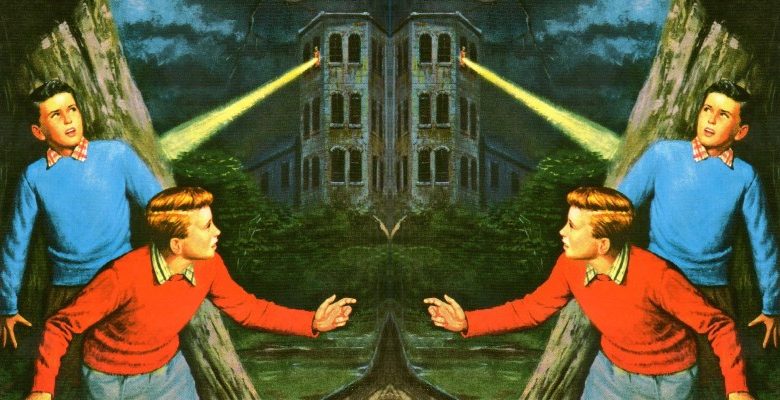[ad_1]
The story of Stephanie’s life is a game of connect-the-dots. It just takes me time to connect them, and the hues and shades of who she was start to fill into a complete portrait, even though it’s still only in two dimensions. It is her murder that will ultimately define her—that will set her apart, that will draw attention to her life. But the story of her murder is a rabbit warren, a maze with a hundred dead ends. In my quest to understand my stepsister, I become a detective too, looking for meaning, for truth. For anything.

When I first started writing about Stephanie back in 2009, aimlessly trying to make sense of her dominion of my mind, my mom gave me a big canvas tote bag full of folders of articles and letters Jerry had organized by year, the last labeled “Stephanie—Final.” I scrutinized every story, every page. So of course there was a lot I knew before I ever met DA Sandra Doorley.
After my trips to Rochester and D.C. in the summer of 2015, I need to be away from the distractions of New York City—the beach, my friends, dating, all of it. So I spend three weeks in that cabin in southern Vermont, surrounded by green. There’s a porch where I sit during the day that overlooks a stream, and that view, that stream, coalesces with my imaginings of the terrain where Stephanie was found. My only writing buddies are a deer and a fox who come by each evening before I make dinner. My routine is simple, monastic almost. I eat, drink a glass or two of wine as I reread anything I’ve managed to write, and climb the steep stairs to the loft bedroom.
I spend most of my time either on the phone with Stephanie’s friends, or scouring the over seven hundred files on the CD Sandra handed me that day in her office. The files are numbered in no sensible order, with no descriptions, so as I read every single one, I rename it. In the end I have a massive index of points of reference for the investigation into Stephanie’s disappearance. “Dave Connors first three days.” “Map of Northampton Park with Shawcross locations.” “Jiffy Lube receipt July 31.”
I want to absorb anything and everything connected to Stephanie’s disappearance. I think if I can grasp the facts of her death, maybe her life will begin to become real too. Maybe if I can inculcate myself in the minutiae, somehow the insight I seek will be attainable. There is a way in somewhere among these forms and notes and records, I think.
And that’s how I find myself, via their own written words in the sea of records on Sandra’s CD, in the minds of two men whose lives were indelibly marked by Stephanie’s life and death: Tom, the boyfriend who found his girlfriend’s apartment empty, and Sergeant David Connors, the man who became as fixated on finding Stephanie originally as I am now.
Here’s the version of events Tom told the police:
That first night after she went missing, Friday, August 2, 1991, he paced, his breath quickening, outside Stephanie’s apartment building. If it had been during the school year, and Stephanie hadn’t shown up for work, someone might have noticed sooner. But Stephanie had only missed a few lessons. Maybe she’d forgotten or made other plans. It was summer vacation; the students weren’t worried. But Tom was.
He decided to drive to his sister Dee’s house. But Dee hadn’t heard from Stephanie. Neither had his sister Molly.
“Molly,” Tom said, “something’s wrong.”
Molly suggested he call Maxine, who told him she’d seen Stephanie two nights earlier. “I have keys to her apartment,” Maxine told him. So he drove to Maxine’s place.
“Do you think she’s mad at me?” he asked, standing in the doorway. He couldn’t imagine why she would be, but there was no other explanation for her sudden disappearance.
Just two days earlier, Maxine had seen the sun shine on Stephanie’s face as she laughed, holding her ice cream cone, and said, “Maybe I’ll move to Ithaca!”
Maxine shook her head. “Not at all, Tom,” she told him.
*
Tom let himself into Stephanie’s place, nervous about what he would find. He saw a bottle of Poland Spring water, full and unopened, on the floor in the doorway to the kitchen. Her violin was next to her open music stand, poised to be played. The pillows were neatly arranged on the bed, sheets folded on a nearby chair as though the bed was about to be made. The coffee maker was set up to brew morning coffee at the push of a button. Chubie and the parakeets twittered in their cages. Everything waited for the touch of Stephanie’s hands. But there was no Stephanie.
Tom pressed play on the answering machine. Kids and their parents, their voices glib, wondering where Stephanie was and why she’d missed their Thursday lessons. His gut felt tight as he sat on the couch and stared at the wall, trying to think of what to do next and drawing blanks.
Tom called Maxine and Molly again, hoping they’d heard from Stephanie or had more of an idea of how to move forward than he did. He also called Stephanie’s student Heidi’s mother, who was just as dumbfounded as he was.
At 8:54 p.m. he called Jerry Kupchynsky, whom he’d never met and to whom he’d never spoken. Stephanie was supposed to be driving to New Jersey the next morning to teach at Jerry’s conference, and Jerry had last heard from her when she left a message Wednesday night. He’d assumed he would see her when she arrived at the conference.
Jerry suggested calling the police soon. He and Tom spoke seven times that night. Tom also dialed information for Melanie, Stephanie’s sister, living in Chicago, and called her twice; she didn’t answer.
Next he looked in Stephanie’s address book and called a few of Stephanie’s friends in Martha’s Vineyard; no one there had heard from her. He called Park Ridge Hospital to ask if there had been an accident. There hadn’t. He called Maxine again around 11:00. “I still can’t find her,” he said.
“Maybe it’s a good idea to call the police now,” she said.
An hour later, Tom sat across from a Greece police officer in Stephanie’s halogen-lit apartment as the officer began a missing persons report. It was 12:01 a.m. on August 3. The apartment that was so familiar to Tom—the couch he had lain on with Stephanie in his arms, the kitchen where she made him coffee with Chubie perched on her shoulder—had become this scene of tense bureaucracy.
Tom said it was uncharacteristic of Stephanie to have broken appointments; he wondered if she was in the midst of some sort of mental health episode. “She actually stopped taking her Prozac a few days ago, so I’m worried. We haven’t spoken since Wednesday,” he said.
In fact, it had been Tuesday when they spoke—one of the glitches in his story that later raised the cops’ hackles.
When the official forms were finished, Tom climbed into the squad car in a daze. They went to see if Stephanie’s car was parked at the Tops market on Maiden Lane, two miles away, where Stephanie often shopped. It wasn’t there. The officer returned Tom to Stephanie’s place in Newcastle Apartments and said they’d call him with any updates.
Alone again, Tom leafed through Stephanie’s address book again and found a number for her new therapist, Pamela Rodgers. He dialed the number at about 3:00 a.m., and a groggy woman answered the phone. He explained who he was, though of course she had heard his name before.
“Stephanie is missing,” he said, hoping she might have some insight.
“We should retrace her steps,” Pamela replied. “But you need to sleep. People will be counting on you.” He tried to sleep in Stephanie’s bed; instead, he kept awaking in intense panics.
On Saturday morning, not sure if he’d slept at all, he called the Greece police again. “An APB is going out at eight, but really, Mr. Redmond, nothing suggests foul play,” said the voice on the other end.
To Tom, the cops seemed nonchalant. That same weekend in Greece, there had been a home invasion and sexual assault, as well as a burglary and shooting that left one person permanently paralyzed. A missing persons report like this was neither uncommon nor alarming, the police said. Stephanie probably needed a break and was somewhere with a friend or alone to collect her thoughts. That was usually how these things turned out, they said.
“She wouldn’t do this to me,” Tom insisted when he called them again. They listened with disinterest, and he hung up the phone each time feeling almost spurned.
There was a blizzard of phone calls to and from Stephanie’s landline that left Tom feeling tired and disoriented, unsure to whom he’d spoken. Somehow Molly, Dee, and Tom’s brother Niall materialized in Stephanie’s apartment.
As they talked through plans and possibilities, Stephanie’s therapist called with an idea. “Look for the car yourselves. Check the airport, the bus terminals, the malls.”
At about 1:00 a.m. on August 4, Niall and his wife began combing the airport parking lots. They found three red Sentras and scrawled down the license plate numbers. Back at home, Niall checked that slip of paper against the number Tom had read to him over the phone that morning. He dialed Stephanie’s phone number.
“I found her car,” he told Tom.
*
In a daze, Tom found himself back in a squad car, this time being driven to the airport. He recognized the Nissan immediately. “Yes,” he said, not quite able to believe his eyes. “That’s Steph’s car.”
The officers slim-jimmed the door open. Inside they found a shopping bag in the back seat, and two disconcerting details. The first was Stephanie’s wallet, with her credit cards and ID, in the glove compartment. If she’d flown somewhere, even just to escape for a while, wouldn’t she need her wallet? The second thing was the driver’s seat, which had been pushed all the way back. Too far for Stephanie, who was only five foot four, to reach the pedals. Was someone else driving?
Tom watched as the Sentra was towed away. An officer’s voice broke through his haze, saying not to worry. Stephanie was young, she’d probably met someone in a bar. “It happens all the time,” the officer said. She’d show up soon.
Overwhelmed and unable to think clearly, Tom went back to Stephanie’s apartment to call Jerry. Then, maybe, he slept. He wasn’t sure.
“She’s allowed, as an adult, to do whatever she wants,” the police kept saying. But Tom, Dee, and Molly insisted this was not their Stephanie. Something terrible has happened, they repeated.
“Please stop calling so much,” someone at the station told Tom.
In desperation, Tom and his sisters decided to muster the media’s power. Around 10:00 a.m. that Sunday, August 4, Tom called Channel 13, Rochester’s ABC network, and spoke to an assignment editor.
“My girlfriend is missing,” he said. He asked if they’d air the story on the evening news. Anything might help.
That evening Tom retold his story on camera, the same one he had told the police and would tell again and again, adding that Stephanie’s car had been found at the airport with the keys gone and her wallet in the glove box.
At some point soon after Melanie and her husband, Ed, arrived—Tom couldn’t remember when, maybe a day or two after his interview for Channel 13—Tom went into Stephanie’s room for a nap. Picking up one of the pillows, he noticed a small stain on the bare mattress.
“I called Mel in to look at it. I can’t remember who else was there,” he wrote in his statement. “We started looking around the room. I finally picked up the sheets from the chair. They were twin-size. They weren’t for her bed; they were for her trip to New Jersey.”
In a nauseating epiphany, they realized that the sheets from her bed were missing—that they had been missing the whole time.
___________________________________________

From CATCH THE SPARROW: A SEARCH FOR A SISTER AND THE TRUTH OF HER MURDER by Rachel Rear. Copyright ©2022 by Rachel Rear. Reprinted by permission of the publisher, Bloomsbury.
[ad_2]






